Attached files
| file | filename |
|---|---|
| 8-K - FORM 8-K - Howmet Aerospace Inc. | d920699d8k.htm |
| EX-3 - EX-3 - Howmet Aerospace Inc. | d920699dex3.htm |
| EX-99.2 - EX-99.2 - Howmet Aerospace Inc. | d920699dex992.htm |
Exhibit 99.1

SUSTAINABILITY AT A GLANCE 2014 2014 Sustainability Highlights • Our absolute greenhouse gas emissions declined by 3 million metric tons, or 6.8%, in 2014. • We were included in the Dow Jones Sustainability Indexes for the 13th consecutive year. • We unveiled the Alcoa Micromill™ technology, which will manufacture the most advanced aluminum sheet on the market. • We introduced the Ultra ONE™ heavy-duty truck wheel, which is 47% lighter than a steel wheel of the same size. • We had zero employee fatalities and one contractor fatality. • For the second year in a row, we were named the world’s most active organization by the Global Corporate Challenge. • Alcoa and Alcoa Foundation invested US$38.4 million in community programs. Sustainability Strategy At Alcoa, we define sustainability as using our Values to build financial success, environmental excellence, and social responsibility in partnership with all stakeholders. In 2009, we developed a new set of long-term strategic sustainability goals and objectives to drive progress in our businesses by 2020 and, for some areas, by 2030. In late 2014, we initiated a review of our long-term sustainability strategy to identify targets that more fully align with our overall transformation strategy. While we have always been focused on reducing our impacts—and will continue to make that a priority—we believe there are additional opportunities to better capture the value our lightweight metal products and solutions bring to customers and society through lightweighting and reduced energy consumption in the use phase. The comparison between our impacts (footprint) and the benefits that we provide to our customers and society (handprints) is what we refer to as our “net-positive” approach. We believe that our current targets do not fully capture those benefits and will continue building out this new net-positive concept throughout 2015 and beyond. Material Aspects Material aspects are a company’s most significant economic, environmental, and social impacts. Using stakeholder input in accordance with the Global Reporting Initiative’s G4 guidelines, we identified our material aspects as greenhouse gas emissions, energy, health and safety, economic performance, environmental footprint (emissions and waste), local communities, and biodiversity. “In 2014, Alcoa accelerated our transformation to build our multi-material value-add businesses and create a globally competitive commodity business. Besides driving profitable growth, the transformation is advancing sustainability for Alcoa and our customers. Alcoa’s businesses are delivering innovative products and solutions that create a more energy-efficient world and meet ever- increasing demands for lightweighting in automotive and aerospace.” Klaus Kleinfeld Alcoa Chairman and Chief Executive Officer SCAN TO READ the full Chairman & CEO Statement.

GROWING HANDPRINT OUR Our lightweight metal innovations create a more sustainable world while helping solve some of society’s biggest challenges. Products The global markets in which we compete are increasingly driven by significant challenges, including urbanization, climate change, and resource scarcity. Our inherently sustainable products are making significant contributions to the world by addressing those challenges. Lightweight, strong, durable, and recyclable, our products save energy and reduce greenhouse gas emissions. They allow engines to run faster and hotter. They enable smart buildings, sustainable food and beverage packaging, high-performance defense vehicles, deeper oil and gas drilling, and more efficient power generation. Aerospace Our high-performance aluminum, titanium, and nickel-based alloy products can be found from nose to tail on today’s commercial aircraft. These products produce lighter, more fuel-effi-cient planes with highly efficient engines and smaller carbon footprints—all without compromising safety, performance, and durability. We have developed new aluminum alloys and third-generation aluminum-lithium alloys that are up to 7% less dense than the current generation. We also developed the forging for the world’s first hybrid-metallic fan blade, which has a 15% stronger microstructure than previous forgings. Hybrid-metallic fan blades Photo courtesy of Pratt & Whitney To meet growing demand, we have continued to expand our aluminum-lithium capacity and capabilities at multiple locations around the world. We also acquired Firth Rixson, a leader in aerospace jet engine components, and TITAL, a leader in titanium and aluminum structural castings for aircraft engines and airframes, in 2014 and early 2015, respectively. In March 2015, we announced an agreement to acquire RTI International Metals, a global supplier of titanium and specialty metal products and services for the commercial aerospace, defense, energy and medical device markets. Automotive Reducing weight is a key enabler for automakers to manufacture cars and light trucks that are more fuel-efficient and emit less carbon dioxide (CO2) in order to meet consumer demands and tightening emissions regulations. Photo courtesy of Ford Motor Company Ford F-150 truck Our lightweight solutions for the automotive market include body sheet, brazing sheet, wheels, extrusions, and automotive fasteners. Compared to steel, these products can provide up to a 50% weight reduction. The aluminum-intensive 2015 Ford F-150 truck, for example, weighs 700 pounds less than its predecessor. Our Alcoa 951 bonding technology, which enables the mass production of aluminum-intensive vehicles like the F-150 truck, received the prestigious R&D 100 Award in 2014. In 2014, we unveiled the Alcoa MicromillTM technology, which will manufacture the most advanced aluminum sheet on the market. Automotive parts made with Alcoa Micromill material will be twice as formable and 30% lighter than parts made from high-strength steel. We also introduced four specialty foundry alloys during 2014 that enable lightweighting and boost performance.
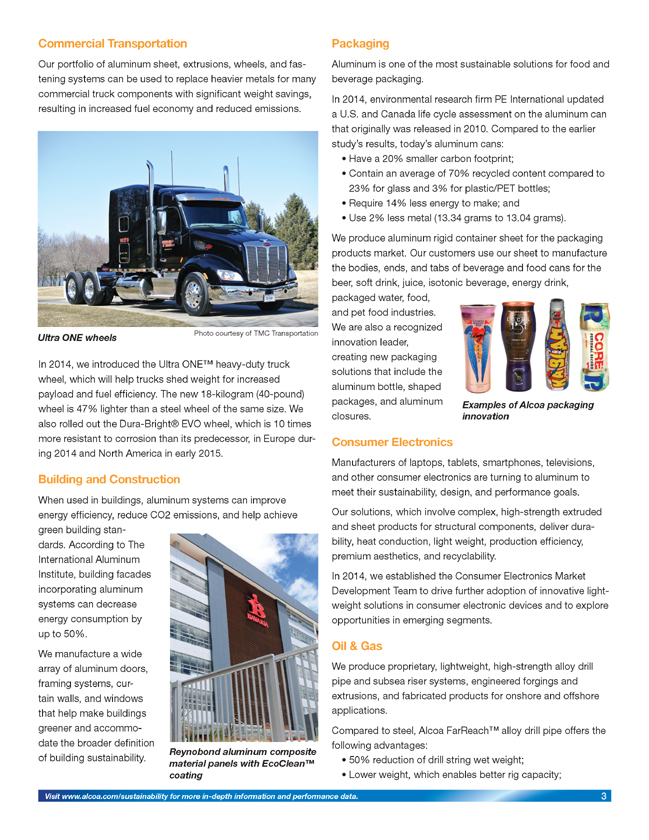
Commercial Transportation Our portfolio of aluminum sheet, extrusions, wheels, and fastening systems can be used to replace heavier metals for many commercial truck components with significant weight savings, resulting in increased fuel economy and reduced emissions. Ultra ONE wheels Photo courtesy of TMC Transportation In 2014, we introduced the Ultra ONE™ heavy-duty truck wheel, which will help trucks shed weight for increased payload and fuel efficiency. The new 18-kilogram (40-pound) wheel is 47% lighter than a steel wheel of the same size. We also rolled out the Dura-Bright® EVO wheel, which is 10 times more resistant to corrosion than its predecessor, in Europe during 2014 and North America in early 2015. Building and Construction When used in buildings, aluminum systems can improve energy efficiency, reduce CO2 emissions, and help achieve green building standards. According to The International Aluminum Institute, building facades incorporating aluminum systems can decrease energy consumption by up to 50%. We manufacture a wide array of aluminum doors, framing systems, curtain walls, and windows that help make buildings greener and accommodate the broader definition of building sustainability. Reynobond aluminum composite material panels with EcoClean™ coating Packaging Aluminum is one of the most sustainable solutions for food and beverage packaging. In 2014, environmental research firm PE International updated a U.S. and Canada life cycle assessment on the aluminum can that originally was released in 2010. Compared to the earlier study’s results, today’s aluminum cans: • Have a 20% smaller carbon footprint; • Contain an average of 70% recycled content compared to 23% for glass and 3% for plastic/PET bottles; • Require 14% less energy to make; and • Use 2% less metal (13.34 grams to 13.04 grams). We produce aluminum rigid container sheet for the packaging products market. Our customers use our sheet to manufacture the bodies, ends, and tabs of beverage and food cans for the beer, soft drink, juice, isotonic beverage, energy drink, packaged water, food, and pet food industries. We are also a recognized innovation leader, creating new packaging solutions that include the aluminum bottle, shaped packages, and aluminum closures. Examples of Alcoa packaging innovation Consumer Electronics Manufacturers of laptops, tablets, smartphones, televisions, and other consumer electronics are turning to aluminum to meet their sustainability, design, and performance goals. Our solutions, which involve complex, high-strength extruded and sheet products for structural components, deliver durability, heat conduction, light weight, production efficiency, premium aesthetics, and recyclability. In 2014, we established the Consumer Electronics Market Development Team to drive further adoption of innovative lightweight solutions in consumer electronic devices and to explore opportunities in emerging segments. Oil & Gas We produce proprietary, lightweight, high-strength alloy drill pipe and subsea riser systems, engineered forgings and extrusions, and fabricated products for onshore and offshore applications. Compared to steel, Alcoa FarReach™ alloy drill pipe offers the following advantages: • 50% reduction of drill string wet weight; • Lower weight, which enables better rig capacity;

• 20% to 30% less torque and drag; • 20% to 30% less string stretch; • Superior horizontal drilling capabilities; • Optimized hydraulic design; and • Improved ergonomics and operating safety. FarReach alloy drill pipe The pipe is also recyclable, adding to its overall sustainability. Defense We develop affordable defense solutions for land, sea, and air that are lighter, faster, and stronger. In addition to high performance, these solutions deliver sustainability through less fuel consumption, lower emissions, and reduced costs. For example, our monolithic bulkhead solution for the Joint Strike Fighter saves weight, reduces total material volume, and simplifies assembly—netting up to a 20% cost savings over a built-up structure. In 2014, we also produced the world’s largest single-piece forged aluminum hull for combat vehicles to increase strength, allowing for better vehicle and troop protection. Joint Strike Fighter Supply Chain We continued our Global Supplier Sustainability Program in 2014 to increase the sustainability of our key suppliers. The program consists of four components—communicate expectations; assess suppliers; develop and educate; and monitor. The formal assessment evaluates the maturity of our key suppliers’ sustainability programs and determines where improvements are needed. In 2014, 83% were rated as either leading or active, with the remaining 17% in the emerging and lagging categories. Supplier Assessment Results Percent of key suppliers Maturity Rating 2011 2012 2013 2014 Leading 16 17 18 16 Active 52 57 60 67 Emerging 22 18 19 15 Lagging 10 8 3 2 In late 2014, we began implementing a third-party supplier due-diligence program with our supplier base. This program will help us manage risk in our supply chain related to the areas of anti-bribery and corruption, trade compliance, child labor, human trafficking, and conflict minerals. Economic Performance MATERIAL ASPECT We operate in many communities throughout the world. Our contributions to those communities, and to society at large, are significant and bring social and economic benefit to regions wherever we operate. 2014 Value Added U.S. dollars Total Sales 23.9 billion Wages & Benefits 5.6 billion Procurement Spend 18.6 billion Income Taxes 301.5 million Alcoa/Alcoa Foundation 38.4 million Community Investments
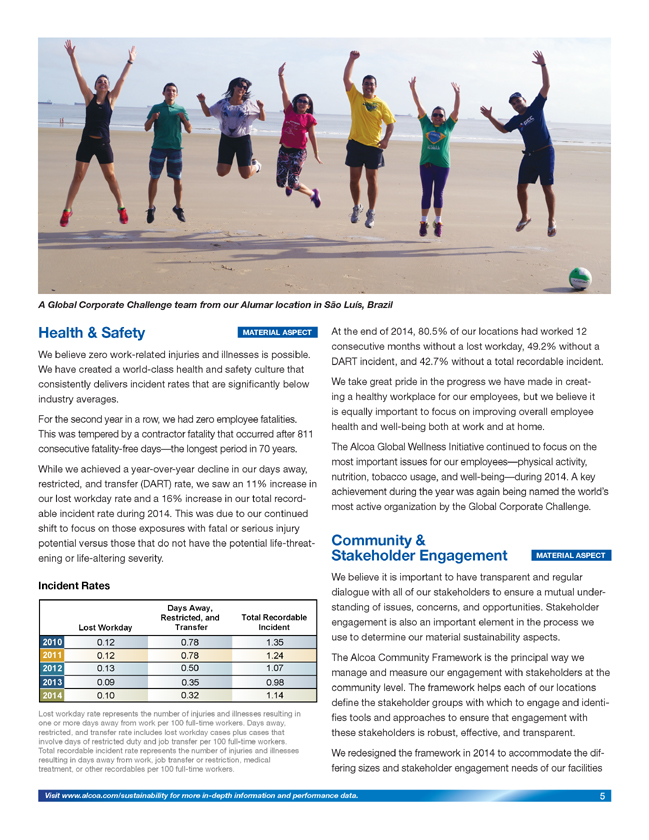
A Global Corporate Challenge team from our Alumar location in São Luís, Brazil Health & Safety MATERIAL ASPECT We believe zero work-related injuries and illnesses is possible. We have created a world-class health and safety culture that consistently delivers incident rates that are significantly below industry averages. For the second year in a row, we had zero employee fatalities. This was tempered by a contractor fatality that occurred after 811 consecutive fatality-free days—the longest period in 70 years. While we achieved a year-over-year decline in our days away, restricted, and transfer (DART) rate, we saw an 11% increase in our lost workday rate and a 16% increase in our total recordable incident rate during 2014. This was due to our continued shift to focus on those exposures with fatal or serious injury potential versus those that do not have the potential life-threatening or life-altering severity. Incident Rates Days Away, Restricted, and Total Recordable Lost Workday Transfer Incident 2010 0.12 0.78 1.35 2011 0.12 0.78 1.24 2012 0.13 0.50 1.07 2013 0.09 0.35 0.98 2014 0.10 0.32 1.14 Lost workday rate represents the number of injuries and illnesses resulting in one or more days away from work per 100 full-time workers. Days away, restricted, and transfer rate includes lost workday cases plus cases that involve days of restricted duty and job transfer per 100 full-time workers. Total recordable incident rate represents the number of injuries and illnesses resulting in days away from work, job transfer or restriction, medical treatment, or other recordables per 100 full-time workers. At the end of 2014, 80.5% of our locations had worked 12 consecutive months without a lost workday, 49.2% without a DART incident, and 42.7% without a total recordable incident. We take great pride in the progress we have made in creating a healthy workplace for our employees, but we believe it is equally important to focus on improving overall employee health and well-being both at work and at home. The Alcoa Global Wellness Initiative continued to focus on the most important issues for our employees—physical activity, nutrition, tobacco usage, and well-being—during 2014. A key achievement during the year was again being named the world’s most active organization by the Global Corporate Challenge. Community & Stakeholder Engagement MATERIAL ASPECT We believe it is important to have transparent and regular dialogue with all of our stakeholders to ensure a mutual understanding of issues, concerns, and opportunities. Stakeholder engagement is also an important element in the process we use to determine our material sustainability aspects. The Alcoa Community Framework is the principal way we manage and measure our engagement with stakeholders at the community level. The framework helps each of our locations define the stakeholder groups with which to engage and identifies tools and approaches to ensure that engagement with these stakeholders is robust, effective, and transparent. We redesigned the framework in 2014 to accommodate the differing sizes and stakeholder engagement needs of our facilities Visit www.alcoa.com/sustainability for more in-depth information and performance data.
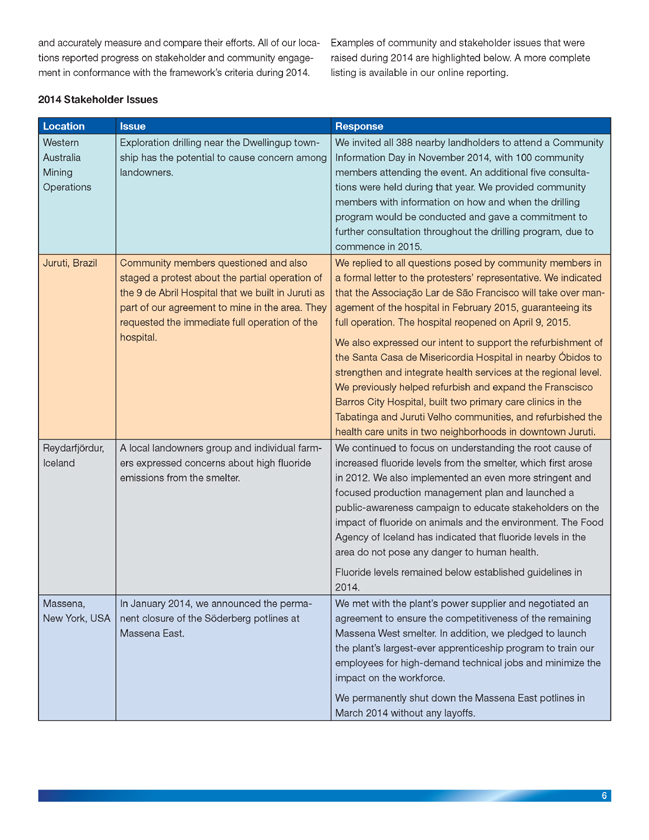
and accurately measure and compare their efforts. All of our locations reported progress on stakeholder and community engagement in conformance with the framework’s criteria during 2014. Examples of community and stakeholder issues that were raised during 2014 are highlighted below. A more complete listing is available in our online reporting. 2014 Stakeholder Issues Location Issue Response Western Exploration drilling near the Dwellingup town- We invited all 388 nearby landholders to attend a Community Australia ship has the potential to cause concern among Information Day in November 2014, with 100 community Mining landowners. members attending the event. An additional five consulta-Operations tions were held during that year. We provided community members with information on how and when the drilling program would be conducted and gave a commitment to further consultation throughout the drilling program, due to commence in 2015. Juruti, Brazil Community members questioned and also We replied to all questions posed by community members in staged a protest about the partial operation of a formal letter to the protesters’ representative. We indicated the 9 de Abril Hospital that we built in Juruti as that the Associação Lar de São Francisco will take over man-part of our agreement to mine in the area. They agement of the hospital in February 2015, guaranteeing its requested the immediate full operation of the full operation. The hospital reopened on April 9, 2015. hospital. We also expressed our intent to support the refurbishment of the Santa Casa de Misericordia Hospital in nearby Óbidos to strengthen and integrate health services at the regional level. We previously helped refurbish and expand the Franscisco Barros City Hospital, built two primary care clinics in the Tabatinga and Juruti Velho communities, and refurbished the health care units in two neighborhoods in downtown Juruti. Reydarfjördur, A local landowners group and individual farm- We continued to focus on understanding the root cause of Iceland ers expressed concerns about high fluoride increased fluoride levels from the smelter, which first arose emissions from the smelter. in 2012. We also implemented an even more stringent and focused production management plan and launched a public-awareness campaign to educate stakeholders on the impact of fluoride on animals and the environment. The Food Agency of Iceland has indicated that fluoride levels in the area do not pose any danger to human health. Fluoride levels remained below established guidelines in 2014. Massena, In January 2014, we announced the perma- We met with the plant’s power supplier and negotiated an New York, USA nent closure of the Söderberg potlines at agreement to ensure the competitiveness of the remaining Massena East. Massena West smelter. In addition, we pledged to launch the plant’s largest-ever apprenticeship program to train our employees for high-demand technical jobs and minimize the impact on the workforce. We permanently shut down the Massena East potlines in March 2014 without any layoffs.
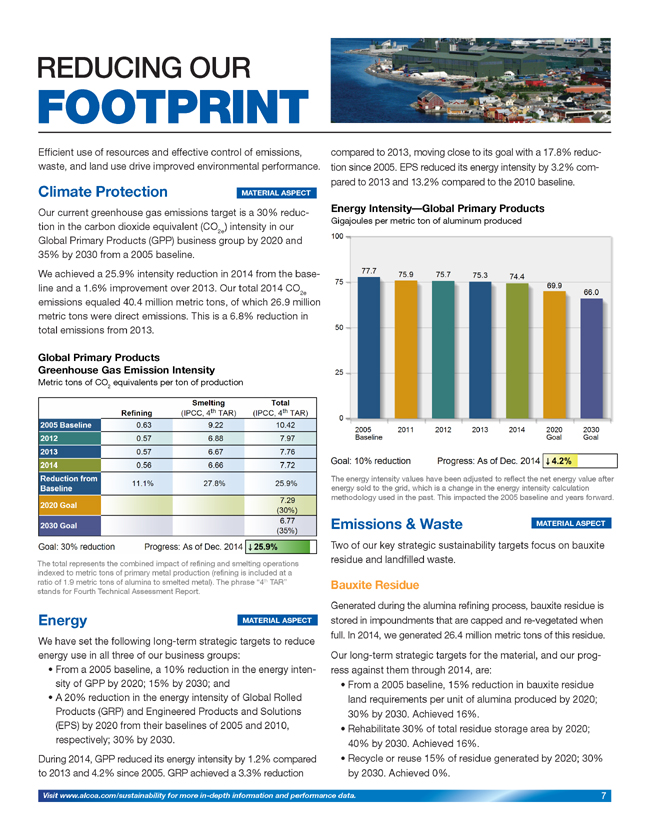
REDUCING OUR FOOTPRINT Efficient use of resources and effective control of emissions, waste, and land use drive improved environmental performance. Climate Protection MATERIAL ASPECT Our current greenhouse gas emissions target is a 30% reduction in the carbon dioxide equivalent (CO ) intensity in our 2e Global Primary Products (GPP) business group by 2020 and 35% by 2030 from a 2005 baseline. We achieved a 25.9% intensity reduction in 2014 from the baseline and a 1.6% improvement over 2013. Our total 2014 CO 2e emissions equaled 40.4 million metric tons, of which 26.9 million metric tons were direct emissions. This is a 6.8% reduction in total emissions from 2013. Global Primary Products Greenhouse Gas Emission Intensity Metric tons of CO equivalents per ton of production 2 Refining Smelting (IPCC, 4th TAR) Total (IPCC, 4th TAR) 2005 Baseline 0.63 9.22 10.42 2012 0.57 6.88 7.97 2013 0.57 6.67 7.76 2014 0.56 6.66 7.72 Reduction from Baseline 11.1% 27.8% 25.9% 2020 Goal 7.29 (30%) 2030 Goal 6.77 (35%) Goal: 30% reduction Progress: As of Dec. 2014 i 25.9% The total represents the combined impact of refining and smelting operations indexed to metric tons of primary metal production (refining is included at a ratio of 1.9 metric tons of alumina to smelted metal). The phrase “4th TAR” stands for Fourth Technical Assessment Report. Energy MATERIAL ASPECT We have set the following long-term strategic targets to reduce energy use in all three of our business groups: • From a 2005 baseline, a 10% reduction in the energy intensity of GPP by 2020; 15% by 2030; and • A 20% reduction in the energy intensity of Global Rolled Products (GRP) and Engineered Products and Solutions (EPS) by 2020 from their baselines of 2005 and 2010, respectively; 30% by 2030. During 2014, GPP reduced its energy intensity by 1.2% compared to 2013 and 4.2% since 2005. GRP achieved a 3.3% reduction compared to 2013, moving close to its goal with a 17.8% reduction since 2005. EPS reduced its energy intensity by 3.2% compared to 2013 and 13.2% compared to the 2010 baseline. Energy Intensity—Global Primary Products Gigajoules per metric ton of aluminum produced The energy intensity values have been adjusted to reflect the net energy value after energy sold to the grid, which is a change in the energy intensity calculation methodology used in the past. This impacted the 2005 baseline and years forward. Emissions & Waste MATERIAL ASPECT Two of our key strategic sustainability targets focus on bauxite residue and landfilled waste. Bauxite Residue Generated during the alumina refining process, bauxite residue is stored in impoundments that are capped and re-vegetated when full. In 2014, we generated 26.4 million metric tons of this residue. Our long-term strategic targets for the material, and our progress against them through 2014, are: • From a 2005 baseline, 15% reduction in bauxite residue land requirements per unit of alumina produced by 2020; 30% by 2030. Achieved 16%. • Rehabilitate 30% of total residue storage area by 2020; 40% by 2030. Achieved 16%. • Recycle or reuse 15% of residue generated by 2020; 30% by 2030. Achieved 0%. Visit www.alcoa.com/sustainability for more in-depth information and performance data.
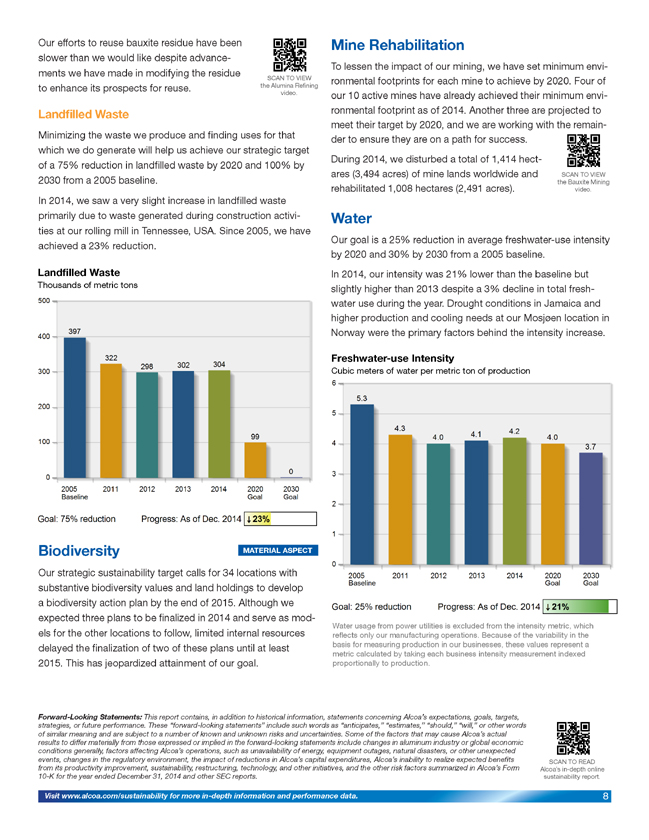
Our efforts to reuse bauxite residue have been slower than we would like despite advancements we have made in modifying the residue to enhance its prospects for reuse. SCAN TO VIEW the Alumina Refining video. Landfilled Waste Minimizing the waste we produce and finding uses for that which we do generate will help us achieve our strategic target of a 75% reduction in landfilled waste by 2020 and 100% by 2030 from a 2005 baseline. In 2014, we saw a very slight increase in landfilled waste primarily due to waste generated during construction activities at our rolling mill in Tennessee, USA. Since 2005, we have achieved a 23% reduction. Landfilled Waste Thousands of metric tons Biodiversity MATERIAL ASPECT Our strategic sustainability target calls for 34 locations with substantive biodiversity values and land holdings to develop a biodiversity action plan by the end of 2015. Although we expected three plans to be finalized in 2014 and serve as models for the other locations to follow, limited internal resources delayed the finalization of two of these plans until at least 2015. This has jeopardized attainment of our goal. Mine Rehabilitation To lessen the impact of our mining, we have set minimum environmental footprints for each mine to achieve by 2020. Four of our 10 active mines have already achieved their minimum environmental footprint as of 2014. Another three are projected to meet their target by 2020, and we are working with the remainder to ensure they are on a path for success. During 2014, we disturbed a total of 1,414 hectares (3,494 acres) of mine lands worldwide and rehabilitated 1,008 hectares (2,491 acres). SCAN TO VIEW the Bauxite Mining video. Water Our goal is a 25% reduction in average freshwater-use intensity by 2020 and 30% by 2030 from a 2005 baseline. In 2014, our intensity was 21% lower than the baseline but slightly higher than 2013 despite a 3% decline in total freshwater use during the year. Drought conditions in Jamaica and higher production and cooling needs at our Mosjøen location in Norway were the primary factors behind the intensity increase. Freshwater-use Intensity Cubic meters of water per metric ton of production Water usage from power utilities is excluded from the intensity metric, which reflects only our manufacturing operations. Because of the variability in the basis for measuring production in our businesses, these values represent a metric calculated by taking each business intensity measurement indexed proportionally to production. Forward-Looking Statements: This report contains, in addition to historical information, statements concerning Alcoa’s expectations, goals, targets, strategies, or future performance. These “forward-looking statements” include such words as “anticipates,” “estimates,” “should,” “will,” or other words of similar meaning and are subject to a number of known and unknown risks and uncertainties. Some of the factors that may cause Alcoa’s actual results to differ materially from those expressed or implied in the forward-looking statements include changes in aluminum industry or global economic conditions generally, factors affecting Alcoa’s operations, such as unavailability of energy, equipment outages, natural disasters, or other unexpected events, changes in the regulatory environment, the impact of reductions in Alcoa’s capital expenditures, Alcoa’s inability to realize expected benefits from its productivity improvement, sustainability, restructuring, technology, and other initiatives, and the other risk factors summarized in Alcoa’s Form 10-K for the year ended December 31, 2014 and other SEC reports. SCAN TO READ Alcoa’s in-depth online sustainability report. Visit www.alcoa.com/sustainability for more in-depth information and performance data.
